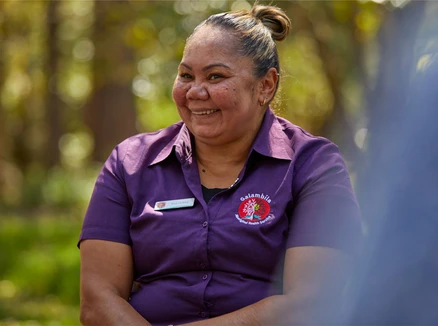Working with community
Community consultation is important, here are some tools to help.
Communicating with Aboriginal and/or Torres Strait Islander people
It is important to be mindful of your approach and communication style when working with Aboriginal and/or Torres Strait Islander people. This guide by the Victorian Aboriginal Community Controlled Health Organisation (VACCHO) outlines recommendations including respectful body language, humour, context and common words used in language in Victoria.
Create a culturally safe environment
Ensure that your service is culturally safe. When possible, employ Indigenous staff, especially females, as doctors, health workers, nurses, receptionists or liaison officers. Provide cultural safety training for healthcare providers and practice staff to build an understanding of culturally-based attitudes towards disease, the importance of culture and tradition, and women’s and men’s business. This training is integral to prepare your team to work respectfully with the Aboriginal and/or Torres Strait Islander community. There are many different communities across Australia, so it is important to undertake training that is relevant to the local community you are working with.
Reconciliation Australia's Share Our Pride online resource is a useful starting point that is designed to take you on an awareness-raising journey. It works through material in a certain order, so each chapter builds on the last. You'll get information on traditional cultures, learn about our shared history and have access to resources. Chapters include: First Australians; Our culture; Our shared history; Beyond the myths and Respectful relationships.
For more in-depth discussion and awareness raising, face-to-face cultural training is recommended. VACCHO is a registered training organisation that provides cultural safety training. You could also contact your local Aboriginal Community Controlled Organisation or local Land Council for contact details of local cultural awareness facilitators.
In addition, Aboriginal and/or Torres Strait Islander artwork and having an Acknowledgement of the Traditional Custodians on a plaque at the front door, will show your respect for Aboriginal and/or Torres Strait Islander people. These plaques can be ordered. Order a plaque.
Develop culturally appropriate resources
Aboriginal and/or Torres Strait Islander artwork and common words are elements to incorporate into making resources culturally appropriate. Some communities would prefer images of Aboriginal and/or Torres Strait Islander people on resources, while others may not. Due to cultural beliefs, it’s common practice in some communities, that when a member of the community is deceased, the person’s name is changed and the images of that person are suppressed. This may be just for a period of time, some cases could vary between six to 12 months. Working with the community is very important for the development of all resources.
Offer flexible services
Offer mobile screening services to Aboriginal and/or Torres Strait Islander communities, flexible appointments, group transportation and/or transportation assistance. Offer opportunistic screening where possible. Enable women to choose between male/female, doctor/nurse, Indigenous/non-Indigenous cervical screening providers.
If necessary, healthcare providers should refer patients to health services which may be more acceptable to perform cervical screening, for example, an Aboriginal medical service. This case study discusses how an Aboriginal medical clinic was able to increase their cervical screening participation rates.
Humour is a great way to engage the Aboriginal and/or Torres Strait Islander community.
Cancer Council Victoria has developed a touring comedy show themed around bowel cancer screening with Aboriginal comedian Denise McGuinness. This has been a successful way to engage the community in a light-hearted yet memorable way and discussed in more detail in this case study.
